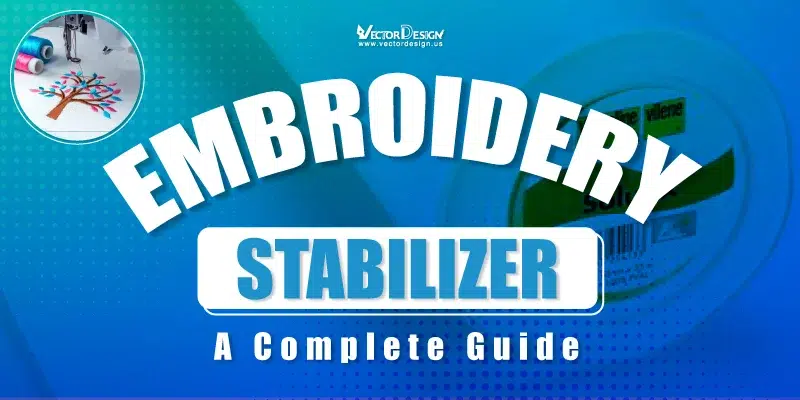Machine embroidery stabilizers are like your embroidery’s best friends. Stabilizers keep your fabric steady. They prevent it from getting messed up. Stabilizers make sure your stitches look nice. The right fabric stabilizer is a must for great embroidery on fancy or delicate fabrics.
In this guide, we’ll explain all about machine embroidery stabilizers. We’ll discuss various stabilizer types. You’ll find out what they work best for and how to use them. We’ll also share both the good and bad sides of these embroidery stabilizers. By the end, you’ll be able to pick the best embroidery stabilizer for awesome results.
What is Embroidery Stabilizer?
Embroidery stabilizer is like a helper for machine embroidery. It’s like a special material you use under or on top of your embroidery fabric. It holds the fabric still and ensures neat stitches. It’s kind of like a foundation that helps your embroidery look its best.
Why Is Stabilizer So Important?
Stabilizer for embroidery is really important. When using a sewing machine for embroidery, fabric may move. Stabilizer keeps fabric steady for accurate stitching. Without stabilizer, your embroidery could end up all messy and not in the right spot.
Some fabrics can get damaged or stretched when you sew on them. Stabilizer acts as a protective layer. It takes the stress of the stitches instead of the fabric, so your fabric stays nice and doesn’t get ruined. In short, embroidery stabilizer is like the unsung hero of embroidery. It keeps your fabric steady and safe while you create beautiful designs with your sewing machine.
Types of Machine Embroidery Stabilizers and When to Use Them
Machine embroidery is fun, but to make it look good, you need “stabilizers.” They keep fabric steady for neat stitches and beautiful designs. In this embroidery stabilizer guide, we’ll explore stabilizers and teach you when and how to use them. Let’s explore stabilizers and choose the perfect one for your embroidery journey.
Tear Away Embroidery Stabilizer
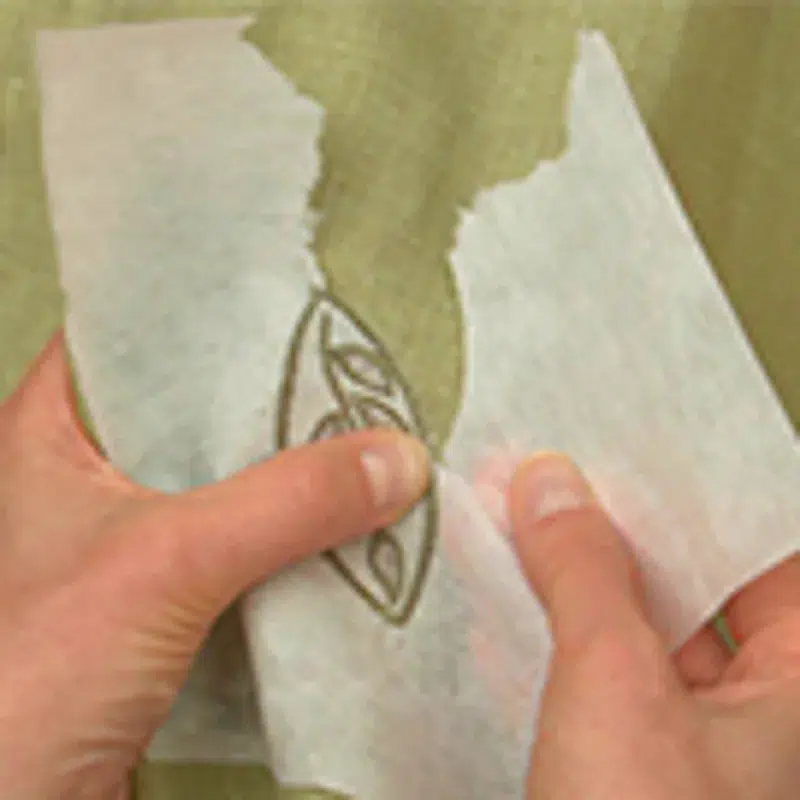
Tear-away stabilizer is a paper-like material that tears easily in one direction. It is available in various weights, with heavier stabilizers offering more support.
Tear-away stabilizer is suitable for stable and medium-weight fabrics. It is commonly used for designs with low to medium stitch counts and is great for embroidery on items like towels, linens, and quilt blocks. It’s easy to tear away from the fabric after the embroidery is complete.
Examples of Tear Away Stabilizers include popular brands like Sulky Tear-Easy, Pellon Easy-Shaper, and Floriani Stitch N Tear.
How to Use:
- Hoop the stabilizer: Place the tear-away stabilizer inside the embroidery hoop.
- Mark the design placement: Use removable fabric markers or a template to mark the design’s center and placement on the fabric.
- Attach the fabric: Position the fabric to be embroidered over the stabilizer, aligning it with the marked design placement.
- Stitch the design: Use your embroidery machine to sew the design onto the fabric. The stabilizer provides temporary support.
- Tear away the excess: After the embroidery is done, gently tear away the excess stabilizer along the perforated edges, leaving only what’s under the embroidery.
Pros:
- Easy to use and remove, making them suitable for beginners.
- Provide good stability for flat fabrics.
- Available in various weights for different fabric types.
Cons:
- Not suitable for stretchy or delicate fabrics, as they may tear the fabric.
- May leave behind some residual bits of stabilizer that need to be cleaned.
Wash Away Embroidery Stabilizers
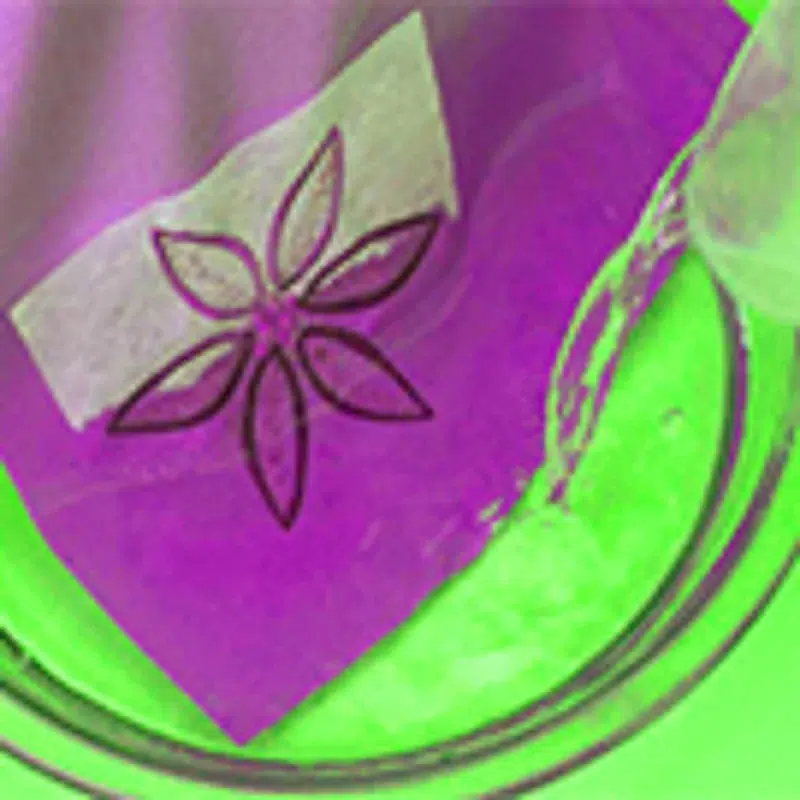
Wash away stabilizers are typically made from materials that dissolve completely in water. They come in various forms, including films, sheets, and fabrics. They are often thin and lightweight.
Wash-away stabilizers are ideal for delicate, lightweight, or sheer fabrics, including organza, tulle, lace, and other transparent textiles. They are particularly useful when you want to maintain the fabric’s original texture, as they leave no residue.
They’re good for delicate lace, cutwork and 3D embroidery with fine details. Additionally, wash-away stabilizers are perfect for skin-touching items because they’re gentle and won’t irritate.
Examples of Wash Away Stabilizers include well-known brands such as Sulky Solvy, Aqua Magic, and Vilene Water Soluble Stabilizer.
How to Use:
- Hoop the stabilizer: Place the wash-away stabilizer inside the embroidery hoop, ensuring it is taut and securely attached.
- Mark the design placement: Use removable fabric markers or a template to mark the design’s center and placement on the fabric.
- Attach the fabric: Position the delicate or lightweight fabric to be embroidered over the stabilizer, aligning it with the marked design placement.
- Stitch the design: Start the embroidery machine and let it stitch out the design. Wash-away stabilizer offers temporary fabric support during embroidery.
- Remove the stabilizer: After the embroidery is complete, carefully remove the fabric from the hoop. Submerge the embroidered piece in water or gently run it under a stream of water to dissolve the stabilizer. Ensure all remnants of the stabilizer are washed away and allow the fabric to dry.
Pros:
- Perfect for delicate and lightweight fabrics, as they won’t damage the material.
- Suitable for lace or intricate, free-standing embroidery.
- Easy to remove by rinsing with water, leaving no residue.
Cons:
- May not be the best choice for fabrics that can’t get wet or might be damaged by water.
- Can be a bit more expensive compared to other stabilizers
Cut Away Embroidery Stabilizers
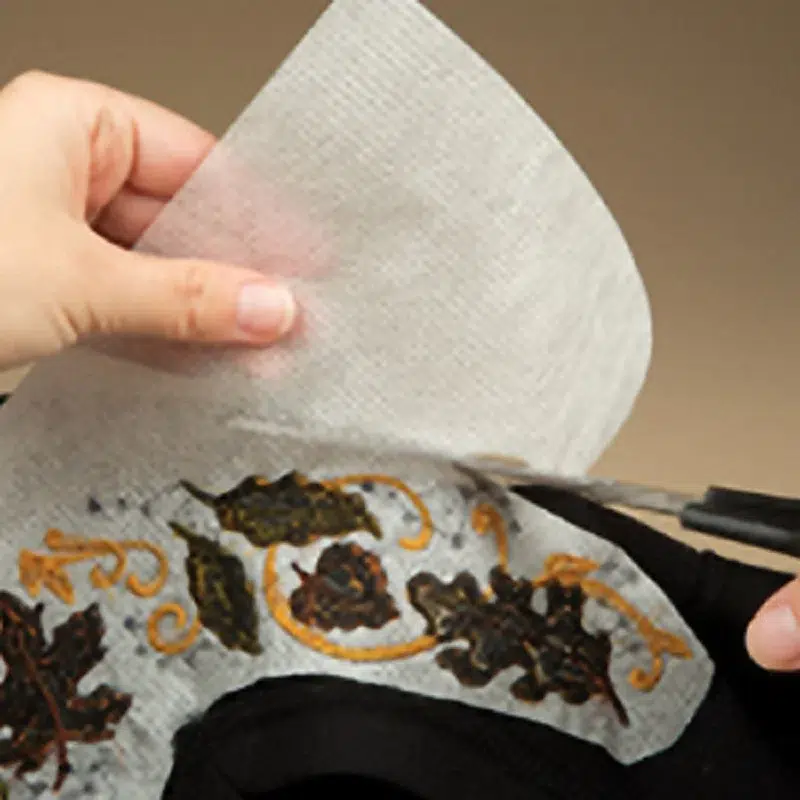
Cut away stabilizers are tough and made of a strong fabric. They don’t tear easily. They come in different weights, from light to heavy. They provide long-term support and stability to embroidered designs.
These embroidery stabilizers are great for fabrics like cotton, denim, or twill. They add extra support for the stitching process. They are best for detailed designs and tough stuff like clothes, towels, and bags.
Examples of Cut Away Stabilizers encompass popular brands such as Floriani Medium Weight Cutaway, Madeira Super Strong, and Pellon Cut-Away Stabilizer.
How to Use:
- Hoop the stabilizer: Place the cut away stabilizer inside the embroidery hoop, ensuring it is taut and securely attached to the hoop.
- Mark the design placement: Use removable fabric markers or a template to mark the design’s center and placement on the fabric.
- Attach the fabric: Position the fabric to be embroidered over the stabilizer, aligning it with the marked design placement.
- Stitch the design: Start the embroidery machine and let it stitch out the design. The stabilizer provides support to the fabric as the stitches are applied.
- Trim excess stabilizer: Once the embroidery is complete, remove the fabric from the hoop, leaving the stabilizer in place. Cut the extra stabilizer from the back, leaving a border for stability.
Pros:
- Suitable for heavy or stretchy fabrics.
- Provides long-term stability to the embroidery.
- Ideal for complex or dense embroidery designs.
Cons:
- Requires trimming of excess stabilizer.
- Not suitable for designs where the back should be completely clean
Mesh Cut Away Stabilizer
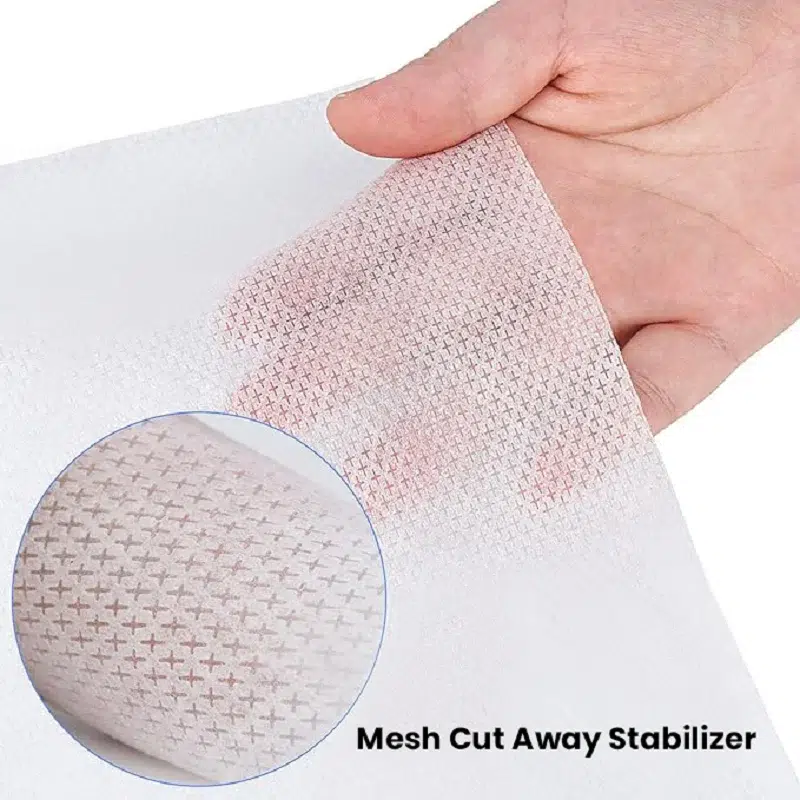
Mesh Cut Away Stabilizer is a specific type of cut away stabilizer with a mesh-like or grid pattern. Some characteristics make it different from traditional cut away stabilizers that are solid and non-woven. Mesh cut away stabilizer offers several benefits. Mesh Cut Away Stabilizer is special because it’s like a grid. This grid helps air flow through, which is great for light and airy fabrics. It’s not thick, so it won’t make your embroidery bulky. And when you’re done, it’s easy to trim away, leaving your project looking neat and professional. It can be used for many different projects, keeping your fabric comfy and supported. An example of Mesh Cut Away Stabilizer is “Floriani No Show Mesh Fusible.”
Heat-Away Embroidery Stabilizer
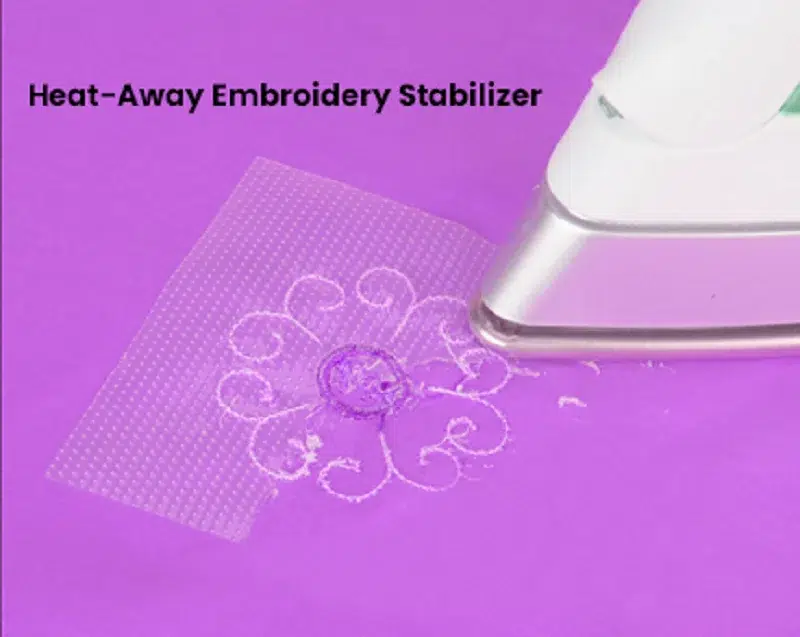
Heat-away stabilizers are typically made of a special material that can be dissolved by heat, such as an iron or heat press. They are often transparent and come in various forms, including films and sheets.
Heat-away stabilizer is great for fabrics that don’t like water, like leather and suede. It’s used for patches, emblems, or motifs on things that can’t get wet. It’s good for projects that need a clean, no-residue finish.
Examples of Heat Away Stabilizers include some popular brands like Sulky Fabri-Solvy, Gunold Filmoplast, and Madeira Heat Dissolving Stabilizer.
How to Use:
- Hoop the stabilizer: Place the heat-away stabilizer inside the embroidery hoop.
- Mark the design placement: Mark where you want your embroidery on the fabric.
- Attach the fabric: Position your fabric over the stabilizer and mark it with the design placement.
- Stitch the design: Use your embroidery machine to sew the design onto the fabric.
- Remove the stabilizer: Carefully take the fabric out of the hoop. Apply heat using an iron or heat press at the temperature recommended by the stabilizer’s manufacturer to make the stabilizer disappear. It leaves no residue on the fabric.
Pros:
- Great for materials that can’t be exposed to water.
- Provides a clean and residue-free finish.
- Ideal for heat-sensitive fabrics.
- Suitable for patches, emblems, and items that need a durable finish.
Cons:
- Limited to heat-friendly fabrics.
- Requires heat application, which may need caution to avoid damaging the fabric or embroidery.
- Not the best choice for heavy fabrics or projects needing long-term support.
- May be a bit more expensive than traditional stabilizers due to its special properties.
Water-Soluble Topping
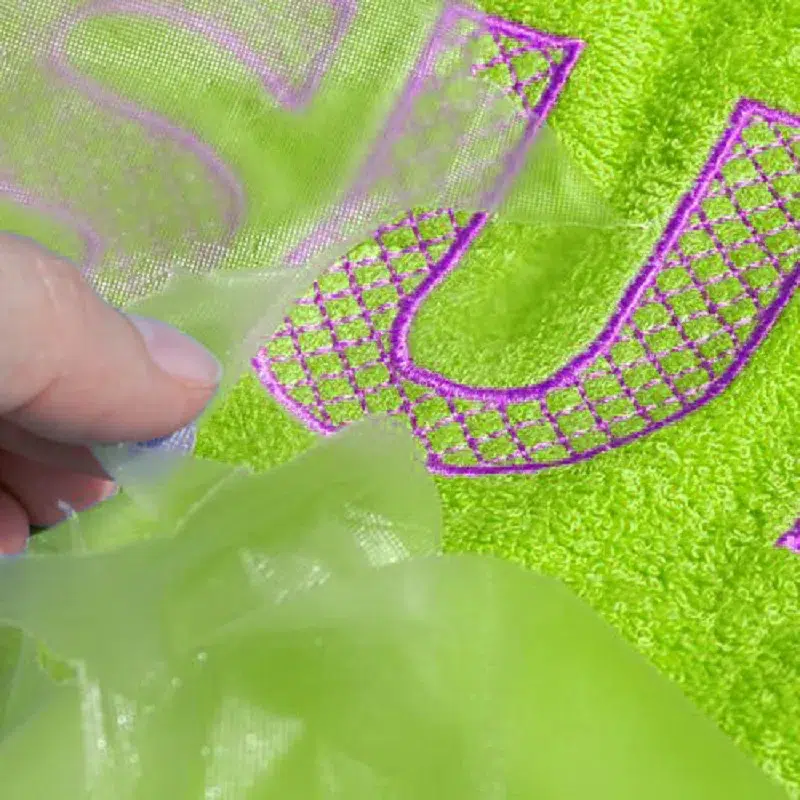
Water-soluble topping is like a thin, see-through plastic sheet that dissolves in water. It’s often used as a temporary cover on top of the fabric during embroidery.
water soluble embroidery stabilizer is perfect for textured fabrics like towels or fleece. It stops stitches from sinking into the fuzz. This topping makes your embroidery look clear and sharp.
Sulky Solvy, Gunold Wash-Away Topping, and Madeira Aquafilm are the examples of Water-Soluble Topping
How to Use:
- Hoop the fabric: Put your fabric in the embroidery hoop.
- Add the topping: Place the water-soluble topping on top of the fabric where you’ll be embroidering. It helps the stitches stay on the surface.
- Start embroidering: Use your embroidery machine to sew the design. The topping keeps the stitches looking sharp.
- Dissolve in water: After you finish, take the fabric out of the hoop and put it in water. The water-soluble topping melts away, leaving your embroidery looking clean.
Pros:
- Makes your embroidery look better on fabrics with lots of texture.
- Easy to use, and it leaves no trace behind.
- Great for enhancing the clarity of your design.
Cons:
- Only works well with fabrics that can get wet.
- Adds a bit of extra time to the embroidery process.
- Not suitable for heavy fabrics or projects needing long-term support.
Factors Affecting Embroidery Stabilizer Selection
Choosing stabilizers embroidery is like picking an artist’s tool. Here we’ll explore how to choose the right stabilizers by looking at the important factors.
- Fabric Type: Different fabrics have varying levels of thickness, texture, and stretch. The choice of stabilizer depends on the fabric you’re embroidering. Lightweight fabrics like chiffon require delicate, tear-away or water-soluble stabilizers, while heavy materials like denim need sturdy cut-away stabilizers.
- Design Complexity: The complexity of your embroidery design influences stabilizer choice. For intricate or high-stitch-count designs, you may need more substantial stabilizers to prevent puckering and distortion.
- Hooping Techniques: How you hoop your fabric matters. Improper hooping can lead to misalignment or puckering. Stabilizers help compensate for hooping mistakes. Choose the right stabilizer for your hooping method, whether it’s floating, hooping both fabric and stabilizer, or using adhesive-backed stabilizers.
- Machine and Thread Settings: Your embroidery machine’s capabilities and thread types can affect stabilizer selection. Adjust the stabilizer to match your machine’s speed, tension, and needle size, as well as the type of thread you’re using.
- Environmental Factors: Environmental conditions matter. Humidity and temperature can impact stabilizer performance. In high humidity, water-soluble stabilizers may dissolve too quickly, so you might choose tear-away or cut-away options. Conversely, in dry conditions, water-soluble stabilizers might be more reliable.
Conclusion
We talked about different types of embroidery stabilizers like tear-away, cut-away, water-soluble, heat-away, and mesh. Each type has its job and works with different fabrics and designs. Stabilizers are like helpers that make your embroidery look clean and neat. They’re super important for getting a professional finish on your work. So, keep experimenting and learning about stabilizers. Practice makes your embroidery look amazing.
FAQs
What is an embroidery stabilizer, and why do I need it?
A stabilizer supports embroidery, ensuring neat results and preventing fabric issues.
How do I choose the right stabilizer for my project?
Consider fabric type, design intricacy, and project requirements to select the ideal stabilizer.
What are the main types of stabilizers, and when should I use them?
There are different types like tear-away and cut-away, each suited to specific fabrics and designs.
Can I use one stabilizer for all projects?
It’s best to match the stabilizer to each project’s unique needs for the best results.
Do I need to remove stabilizer after embroidery?
Yes, it’s recommended to remove or dissolve the stabilizer to achieve a clean, professional finish.
Are there alternatives to traditional stabilizers?
Yes, there are alternatives such as adhesives, but traditional stabilizers are known for their reliability.

